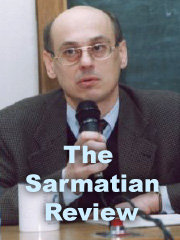| This Issue | Back Issues | Editorial Board | Contact Information |

A Concise History of Polish Theater from the Eleventh to the Twentieth Centuries
Reviewer: Mark F. Tattenbaum
A Concise History of Polish Theater from the Eleventh to the Twentieth Centuries
By Kazimierz Braun. Studies in Theater Arts, vol. 21. Lewiston, NY: The Edwin Mellen Press, 2003. 476 pages. ISBN 0-7734-6791-2. Hardcover. $139.95.
Mark F. Tattenbaum
I recall that when I was Professor Braun's student, he once stood before his class of sophomores and juniors and asked for a definition of "theater." Some brave students offered their opinions of what exactly the phenomenon of theater amounted to. Having allowed the students to roam freely for a while, Professor Braun concluded the discussion by saying that "Theater is an artistic and democratic process of communication between actor and audience, where each side contributes to the exchange." He stressed that it is a two way process, the actor depending on the audience and audience depending on the actor. He let this concept work its way into the minds of his students. Then he asked the next question, "What do you know about the history of the theater?" Hands sprung up but no one was able to give an exhaustive answer. After listening to his students' suggestions, Braun provided a simple yet elegant answer: "The history of the theater is the history of productions."
In his most recent book, Braun provides us with much more than a compilation of productions and dates of productions, although this information is also included. He begins his exploration of the theater of the land of his birth by first examining the early history of Poland.
Unlike America, Poland has been a land that has suffered at the hands of its invaders. As a result of the constantly changing political climate, the Polish theater was, from the outset, an important part of Polish life and history. Unlike its American counterpart which historically has been appreciated for its entertainment value, Polish theater has been a force for political and social change within the Polish society. As the roots of the Polish theater are uncovered, the history of the Polish people is revealed as well. The stage becomes the social and political consciousness of the nation, shaping public opinion and calling its citizens to action. In times of turmoil and great despair it has been a unifying force that has galvanized the citizens against their oppressors. Braun outlines the history of Poland and then fleshes out the details of the growing nation by tracing the development of the theater and all of its actors, directors, and writers. The history is completed by a detailed examination of the various theaters and theater milieux along a time continuum beginning at the eleventh century. As Braun progresses through the ages, he examines all areas of Polish theater history, its response to the various invading forces, and the attempts of a society to cling to its unique identity.
In the later chapters of the book Braun himself becomes a part of the history he deals with. He draws upon his first hand experiences in the Polish theater and provides the reader with an eyewitness' account of the theater milieu's struggle to survive the times of the national catastrophes, first from the Nazi and German domination from the West and then the invasion of the Soviets from the East. He describes some of the horrors endured by the Polish theater artists in the twentieth century. Beyond these fully documented horrors was the determination of the Polish artists to keep the flame of a free Poland alive. Braun details the work of the underground theater movement and the efforts, mostly unknown here in the West, of the Roman Catholic Church in Poland to keep the Polish theater alive. Owing to a different profile of theater entertainment in America, most Americans cannot comprehend the nature of the penalties imposed by the communist regime on what it considered to be dissidents. Braun explains the risks taken by those theater artists who chose to cooperate with the Soviet-controlled Communists and details their careers through their rise in "Socrealism Theater," as well as their eventual fall from the favor of the communist party. The final chapters of the work detail the rise of the Solidarity Labor Movement, the waning and eventual collapse of communism, and the challenges and changes that the Polish theater has had to grapple with at the end of the twentieth century.
This History is illustrated with tables and timelines that further clarify and detail the growth and development of Poland as a nation and its theater milieu. Additionally, Braun has included a "Hall of Fame of The Polish Theater Artists." This section includes fifty drawings, photographs, and descriptions of the artists and their productions, many from the author's private collection. Also included is a geopolitical map detailing the partitioning of the nation by invading armies and the dates of these incursions.
For student and scholar alike, this is a remarkable work. Beginning students will find this well-structured volume an excellent introduction to Poland's theater history. Established scholars will find historical information unavailable elsewhere. The volume is fully annotated with bibliographical references for each chapter, with sources in English and Polish. There are two indexes, one of names and the other of plays, adaptations, scenarios, and collective creations.
Back to the April 2004 Issue
The Sarmatian Review
sarmatia@rice.edu
Last updated 4/23/04